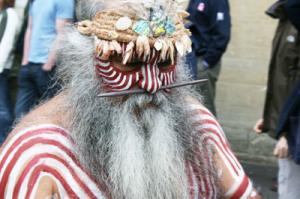
Exploring the history and experiences of mixed heritage persons and inter-racial relationships across the world

Exploring the history and experiences of mixed heritage persons and inter-racial relationships across the world
Aborigine. What comes to mind? Yes, indeed, the indigenous peoples of Australia. However the term comes from a Latin word aborigines, derived from ab (from) and origo (origin, beginning). The use of the word in English which is generally accepted as meaning “first or earliest known person, animal, or plant of a country or region' pre-dates the English settlement of Australia with the arrival of the First Fleet in Botany Bay in 1788. Today when used to refer to the indigenous people of Australia it is capitalised (Aborigine not aborigine) and more often then not as 'Aboriginal Australian'.
Aboriginal or indigenous peoples exist all over the world including the Native Americans of the USA, the Māori of New Zealand and the First Nations of Canada. Using the terms aboriginal or indigenous can be misleading, giving the impression that people being described are all the same people but like the over 600 recognised First Nations people in Canada, the Aboriginal Australia consist of over 400 distinct groups whilst related have different languages, customs and territories. In fact, one Australian group, the Torres Strait Islanders, are culturally and genetically Melanesian people like their relatives the people of Papua New Guinea.
It should not be a surprise that distinct groups/tribes/bands exist within these original peoples. In many cases and in particular in Australia, there was a considerable time for the populations to evolve before the Europeans arrived. Eventually the Europeans did arrive and in many cases, the vast majority of the new immigrants were male. In the less confrontational environment in Canada, as compared to the arrival of the Europeans in the US, interracial mixing occurred on a scale that gave rise to the recognised First Nations peoples – the Métis. The name apparently is of French origin is supposed to mean Half Breed.
The Métis, originating from various European, mainly French, and indigenous groups such as the Mi'kmaq, Algonquin, Saulteaux, Cree, Ojibwe, Menominee and Maliseet developed a distinct Métis culture. Today they make up over 30% of the First Nations peoples who in total make up less than 4% of the Canadian population. Many mixed race communities since such as the Indos of Indonesia and the Coloureds of South Africa and Zimbabwe followed the same route in creating distinct identities. The Métis are distinct groups and modern day mixed race Canadians even those conceived by mixed European and indigenous parentage are not Métis.
The descendants of European men and Australian Aboriginal women were not so lucky. The European settlers through the 'Stolen Generations' policy allowed the removal of mixed race children (called 'half-castes', 'crossbreeds', 'quadroons' and 'octoroons')' from their indigenous mothers under the pretence of responding to their abandonment. The book and the movie 'The Rabbit Proof Fence', which I mention in my Oceania article, depicts a story during this period. The practice only ended in 1969. As in many other colonies, The Canadians also had a system of assimilation through arrangements between the Government and the churches which operated 'residential' schools for indigenous children

Both groups, like many other aboriginal people, have had similar battles in getting official recognition and rights in the countries of their origin. Sadly, the Australian Aborigines appear to have a much longer journey ahead of them in this area, though both groups continually appear to be left out of the mainstream.
Sometimes it is not easy to determine the indigenous population. In Australia for example, some descendants of the early colonialists now regard themselves as indigenous leading some Australian Aborigine people to dislike the term to describe them. In Africa, people of Bantu origin are said to have originated between West Africa and Central Africa but now occupy a large swathe of Central and Southern Africa where they displaced several other indigenous groups particularly the descendants of the oldest humans the Khoikhoi and the San. This may be true in many regions of the world particularly in South East Asia – a subject for a future post.